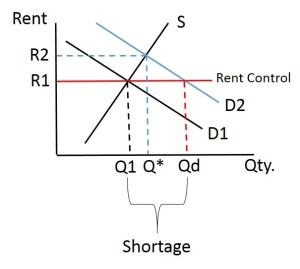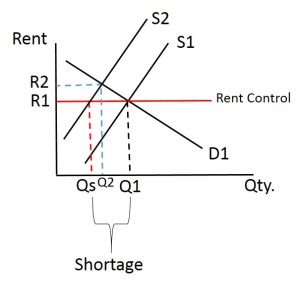State and Local Public Policy from the Mercatus Center, George Mason University
Rent control: A bad policy that just won’t die
by Adam Millsap on July 13, 2015 in City Life, Economic Policy, Regulation
The city council of Richmond, CA is thinking about implementing rent control in their city. Richmond is located north of Berkeley and Oakland on the San Francisco Bay in an area that has some of the highest housing prices in the country. From the article:
“Richmond is growing and becoming a more desirable place where people want to live, but that increased demand is putting pressure on the existing housing stock.”
It is true that an increase in the demand for housing will increase prices and rents. Unfortunately, rent control will not solve the problem of too little housing, which is the ultimate cause of high prices.

The diagram above depicts a market for housing like the one in Richmond. Without rent control, when demand increases (D1 to D2) the price rises to R2 and the equilibrium quantity increases from Q1 to Q*. However, with rent control, the price is unable to rise. For example, if the Richmond city council wanted prices to be at the pre-demand-increase level they would set the rent control price equal to R1. But with the increase in demand the quantity demanded at that price is Qd, while the quantity supplied is only Q1. Thus there is a shortage. This is the outcome of a price ceiling.
What this means is that some people will find a place to rent at the old, lower rental price (Q1 people). But more people will want to rent at that price than there are units available, and since the price cannot rise due to the price control, the available apartments will have to be allocated some other way. This means longer wait times for vacant apartments and higher search costs. It also means lower quality apartments. Since the owners know there are more people who want an apartment than available apartments, they don’t have an incentive to maintain the apartment at the same level as they would if they had to attract customers.
With rent control, only Q1 people get an apartment. Without rent control, as the price rises more units are supplied over time and the new equilibrium has Q* (> Q1) people who get an apartment. Yes, they have to pay a higher price, but the relevant alternative is not an apartment at the lower price: The alternative is that some people who would have been willing to pay the higher price do not get an apartment.
Since Richmond has strict land-use rules like many communities in the San Francisco metro area (you can read all about their minimum lot size and parking space requirements here), rent control is adding to the housing woes of Richmond’s renters and any person who would like to move there.

Land-use restrictions decrease the amount of buildable land which subsequently increases the cost of housing. This is depicted in the diagram above as a shift from S1 to S2. The decrease in supply leads to a new equilibrium rent of R2 > R1 and a reduction in the equilibrium quantity to Q2 (< Q1). So land-use restrictions have already decreased the amount of available housing and increased the price.
If rent control is implemented, depicted in the diagram as the solid red line at the old price (R1), then the quantity supplied decreases even more to Qs. Again, with rent control there is a shortage as the quantity of housing demanded at R1 is Q1 (> Qs). So all of the same problems that occurred in the first example occur here, only here the quantity of housing is decreased not once, but TWICE by the government: Once due to the land use restrictions (Q1 to Q2) and then AGAIN when the rent control is implemented (Q2 to Qs). Restricting the amount of housing available does not help more people find housing, and restricting it again exacerbates the problem.
Trying to find an economist who doesn’t think that rent control is a bad idea is like trying to find a cheap apartment in a city with rent control; it can be done, but you have to spend a lot of time looking. In a Booth IGM poll question about rent control, 95% of the economists surveyed disagreed with the statement that rent control had a positive impact on the amount and quality of affordable rental housing. Yet despite basic economic theory, the agreement among experts, and the empirical evidence (see here, here, and here) rent control remains in some places and is often brought up as a viable policy for increasing the amount of affordable housing. This is truly a shame since what places like Richmond need is more housing, not less housing with artificially low prices. |

